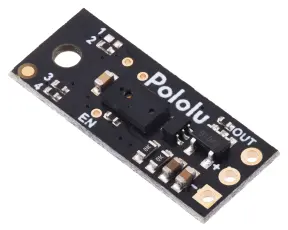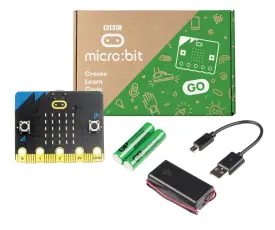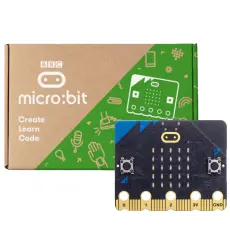Product description
This board is a 3-channel time-of-flight proximity and distance sensor module based on the OPT3101 IC from Texas Instruments. Unlike conventional IR sensors that use the intensity of reflected light to estimate the distance to an object, this board emits 940 nm infrared light pulsed at 10 MHz, and then measures the phase (delay) of the reflected signal, which corresponds to the distance to the target object. It also measures the amplitude of the signal, which indicates how bright/reflective/close the object is.
This board has three channels that each cover approximately 50° to 60°, giving the sensor a wide field of view (FOV). In favorable conditions, the sensor can measure objects at distances up to 1 m. Distance measurements are available through the sensor's I²C interface, which is also used to configure the sensor.
Specifications:
* Dimensions: 27.9 mm × 30.5 mm
* Weight without header pins: 2.7 g
* Operating voltage: 2.5 V to 5.5 V
* Sensor channels: 3 (each with an FOV of approximately 50° - 60° for a combined FOV of nearly 180°)
* Supply current: 130 mA (typical average during operation in high-brightness mode with 3.3 V power supply)
* Distance measuring range: up to 1 m (3.3 ft) (depends on the target object; see the FAQs tab for more information on distance measurement accuracy)
This board has three channels that each cover approximately 50° to 60°, giving the sensor a wide field of view (FOV). In favorable conditions, the sensor can measure objects at distances up to 1 m. Distance measurements are available through the sensor's I²C interface, which is also used to configure the sensor.
Specifications:
* Dimensions: 27.9 mm × 30.5 mm
* Weight without header pins: 2.7 g
* Operating voltage: 2.5 V to 5.5 V
* Sensor channels: 3 (each with an FOV of approximately 50° - 60° for a combined FOV of nearly 180°)
* Supply current: 130 mA (typical average during operation in high-brightness mode with 3.3 V power supply)
* Distance measuring range: up to 1 m (3.3 ft) (depends on the target object; see the FAQs tab for more information on distance measurement accuracy)












